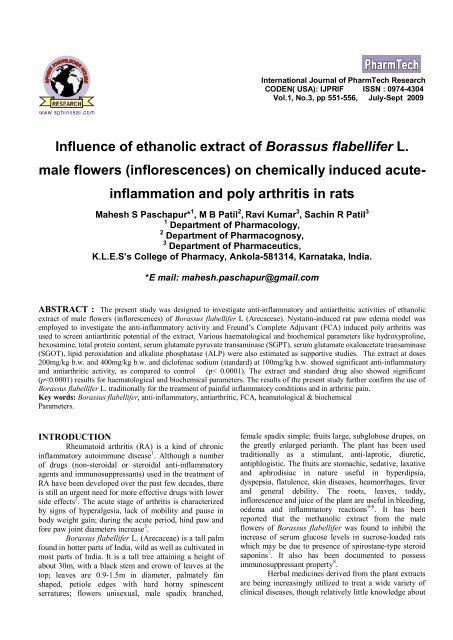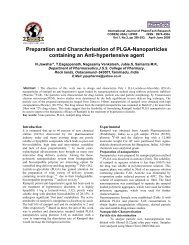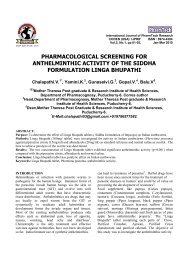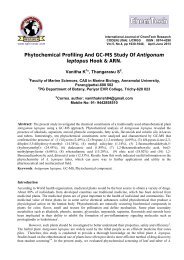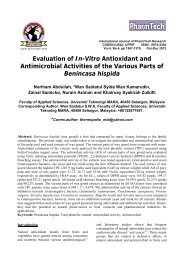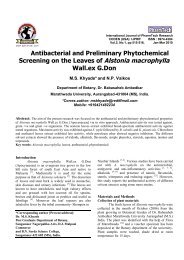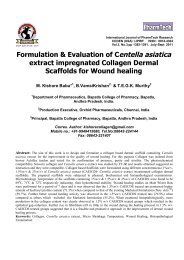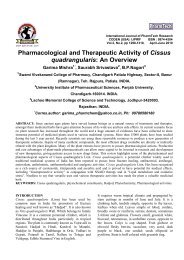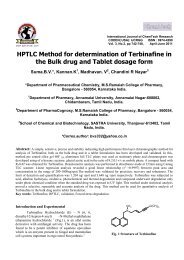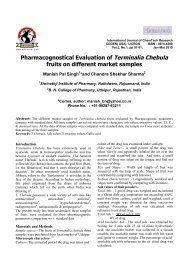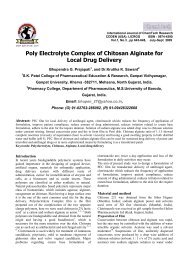Influence of ethanolic extract of Borassus flabellifer L. male flowers ...
Influence of ethanolic extract of Borassus flabellifer L. male flowers ...
Influence of ethanolic extract of Borassus flabellifer L. male flowers ...
Create successful ePaper yourself
Turn your PDF publications into a flip-book with our unique Google optimized e-Paper software.
International Journal <strong>of</strong> PharmTech Research<br />
CODEN( USA): IJPRIF ISSN : 0974-4304<br />
Vol.1, No.3, pp 551-556, July-Sept 2009<br />
<strong>Influence</strong> <strong>of</strong> <strong>ethanolic</strong> <strong>extract</strong> <strong>of</strong> <strong>Borassus</strong> <strong>flabellifer</strong> L.<br />
<strong>male</strong> <strong>flowers</strong> (inflorescences) on chemically induced acute-<br />
inflammation and poly arthritis in rats<br />
Mahesh S Paschapur* 1 , M B Patil 2 , Ravi Kumar 3 , Sachin R Patil 3<br />
1 Department <strong>of</strong> Pharmacology,<br />
2 Department <strong>of</strong> Pharmacognosy,<br />
3 Department <strong>of</strong> Pharmaceutics,<br />
K.L.E.S’s College <strong>of</strong> Pharmacy, Ankola-581314, Karnataka, India.<br />
*E mail: mahesh.paschapur@gmail.com<br />
ABSTRACT : The present study was designed to investigate anti-inflammatory and antiarthritic activities <strong>of</strong> <strong>ethanolic</strong><br />
<strong>extract</strong> <strong>of</strong> <strong>male</strong> <strong>flowers</strong> (inflorescences) <strong>of</strong> <strong>Borassus</strong> <strong>flabellifer</strong> L (Arecaceae). Nystatin-induced rat paw edema model was<br />
employed to investigate the anti-inflammatory activity and Freund’s Complete Adjuvant (FCA) induced poly arthritis was<br />
used to screen antiarthritic potential <strong>of</strong> the <strong>extract</strong>. Various haematological and biochemical parameters like hydroxyproline,<br />
hexosamine, total protein content, serum glutamate pyruvate transaminase (SGPT), serum glutamate oxaloacetate transaminase<br />
(SGOT), lipid peroxidation and alkaline phosphatase (ALP) were also estimated as supportive studies. The <strong>extract</strong> at doses<br />
200mg/kg b.w. and 400mg/kg b.w. and dicl<strong>of</strong>enac sodium (standard) at 100mg/kg b.w. showed significant anti-inflammatory<br />
and antiarthritic activity, as compared to control (p< 0.0001). The <strong>extract</strong> and standard drug also showed significant<br />
(p
Mahesh S Paschapur et al /Int.J. PharmTech Res.2009,1(3) 552<br />
their mode <strong>of</strong> action is available. A bibliographic survey<br />
showed that there are no reports on the antiarthritic and<br />
anti-pyretic activity <strong>of</strong> <strong>Borassus</strong> <strong>flabellifer</strong>. This<br />
prompted us to investigate the effects <strong>of</strong> pharmacological<br />
activities <strong>of</strong> <strong>Borassus</strong> <strong>flabellifer</strong> in experimental models<br />
<strong>of</strong> the same.<br />
EXPERIMENTAL<br />
Plant Material<br />
The <strong>male</strong> <strong>flowers</strong> (inflorescences) <strong>of</strong> <strong>Borassus</strong><br />
<strong>flabellifer</strong> L. (Arecaceae) were collected from various<br />
parts <strong>of</strong> Uttar Kannada district, Karnataka during<br />
November to December and were authenticated from Mr.<br />
Shivanand Bhat, Department <strong>of</strong> Botany, Government<br />
Arts and Science College, Karwar, Karnataka, India. The<br />
selected parts <strong>of</strong> the plant were then dried in shade at<br />
temperature between 21-30°C for 15 to 30 days, after<br />
which these parts were chopped and ground. Finally<br />
<strong>extract</strong>ion was carried out by the following procedure.<br />
Preparation <strong>of</strong> the Extract<br />
The powdered crude drug <strong>of</strong> <strong>male</strong> <strong>flowers</strong> (800g)<br />
was subjected for <strong>extract</strong>ion process by maceration with<br />
90% ethanol at room temperature for 7 days. The <strong>extract</strong><br />
was filtered and concentrated to dryness at room<br />
temperature to avoid the decomposition <strong>of</strong> natural<br />
metabolites. The yield was found to be approximately<br />
5.18% w/w.<br />
Chemicals<br />
All the drugs used in this study were <strong>of</strong><br />
pharmaceutical grade. Nystatin was supplied by Nicholas<br />
Piramal, New Delhi, Freund’s Complete Adjuvant (FCA)<br />
(Diclo Labs, USA), Hydroxyproline (Spectrochem Pvt.<br />
Ltd., Mumbai, India), Glucosamine (Sisco Labs,<br />
Mumbai, India), Pure Dicl<strong>of</strong>enac Sodium was gifted by<br />
Dr. Reddy’s Laboratories, Hyderabad, India.<br />
Experimental Animals<br />
Swiss Albino Mice (25-30g) and Wister Albino<br />
Rats (180-210g) <strong>of</strong> either sex were used in the study.<br />
They were procured from Venkateshwara Enterprises,<br />
Bangalore, Karnataka, India. They were randomly<br />
distributed into groups and housed in cages (6 per cage)<br />
and maintained under standard conditions at 26 ± 2°C<br />
and relative humidity 44–56% and 10h light: 14h dark<br />
cycles each day for one week before and during the<br />
experiments. All animals were fed the standard rodent<br />
pellet diet (Amrut, India) and water ad libitum. This<br />
project was cleared by Institutional Animal Ethical<br />
Committee.<br />
Acute Toxicity Studies<br />
Swiss albino mice <strong>of</strong> either sex (18-22g weight)<br />
were used for acute oral toxicity study. The study was<br />
carried out as per the guidelines set by OECD and no<br />
adverse effects or mortality were detected in the mice up<br />
to 4g/kg, p.o., during the 24h observation period. Based<br />
on the results obtained from this study, the dose for anti-<br />
inflammatory activity was fixed to be 200mg/kg b.w. and<br />
400mg/kg for dose dependent study.<br />
ANTI-INFLAMMATORY ACTIVITY<br />
The animals were divided into four groups<br />
(n=6). Group I served as Control, received the vehicle<br />
only (1% Carboxymethylcellulose, CMC, 10ml/kg p.o.).<br />
Group II served as Standard, received Dicl<strong>of</strong>enac Sodium<br />
at dose <strong>of</strong> 100mg/kg b.w. Group III and IV served as<br />
test, received <strong>ethanolic</strong> <strong>extract</strong> at doses <strong>of</strong> 200mg/kg and<br />
400mg/kg b.w. p.o. respectively.<br />
1. Nystatin-induced inflammation in Rat paw 9<br />
The animals pretreated with <strong>extract</strong> or dicl<strong>of</strong>enac<br />
sodium one hour before were injected with 0.1 ml <strong>of</strong> 6%<br />
suspension <strong>of</strong> Nystatin subcutaneously under plantar<br />
neurosis in right hind paw. Paw volume was measured by<br />
dislocation <strong>of</strong> the water column in a Plethysmometer<br />
(Ugo Basile, Italy) immediately after Nystatin application<br />
at 2, 4, 6, 24, 48, 72hr after the stimulus. Nystatin induces<br />
inflammation reaction by labilising the lysosomal<br />
membrane. Reduction in the paw volume compared to the<br />
vehicle-treated control animals was considered as antiinflammatory<br />
response.<br />
ANTIARTHRITIC ACTIVITY<br />
1. Freund’s Adjuvant induced Poly arthritis 10<br />
Rats were injected, 0.1ml <strong>of</strong> FCA into the subplantar<br />
region <strong>of</strong> the right hind paw. Paw volume was<br />
measured by dislocation <strong>of</strong> the water column in a<br />
Plethysmometer (Ugo Basile, Italy) on day 0<br />
(before administration <strong>of</strong> FCA) and at every 5 days<br />
during the treatment period ending on day 21. All the<br />
animals received either <strong>extract</strong> or dicl<strong>of</strong>enac sodium or<br />
vehicle (1% CMC) orally depending upon their<br />
respective grouping for 21 consecutive days from the day<br />
<strong>of</strong> FCA injection. On 21 st day, rats were anaesthetized<br />
using diethyl ether and oedematous tissues were isolated<br />
from the injected hind paw and were assayed for<br />
hydroxyproline 11 , hexosamine 12-13 and total protein<br />
content 14 . Blood was withdrawn from retro-orbital plexus<br />
<strong>of</strong> all the groups and various haematological and<br />
biochemical parameters were estimated.<br />
RESULTS<br />
Rheumatoid arthritis is a chronic inflammatory<br />
disease affecting about1% <strong>of</strong> the population in developed<br />
countries 15 . <strong>Borassus</strong> <strong>flabellifer</strong> has shown the persuasive<br />
protective effect against the acute and chronic<br />
inflammation induced various chemicals is here<br />
investigated for the protective effect against chronic<br />
inflammation and arthritis induced by CFA. The acute<br />
stage <strong>of</strong> arthritis is characterized by signs <strong>of</strong> hyperalgesia,<br />
lack <strong>of</strong> mobility and pause in body weight gain; during<br />
the acute period, hind paw and fore paw joint diameters<br />
increase 16 .<br />
The result <strong>of</strong> <strong>ethanolic</strong> <strong>extract</strong> <strong>of</strong> <strong>Borassus</strong><br />
<strong>flabellifer</strong> <strong>male</strong> inflorescences against nystatin-induced
Mahesh S Paschapur et al /Int.J. PharmTech Res.2009,1(3) 553<br />
paw oedema is shown in Table 1. The result shows that<br />
the <strong>extract</strong> at both the doses (200mg/kg b.w. and<br />
400mg/kg b.w.) gave the significant (P
Mahesh S Paschapur et al /Int.J. PharmTech Res.2009,1(3) 554<br />
Table1: Effect <strong>of</strong> ethanololic <strong>extract</strong> <strong>of</strong> <strong>Borassus</strong> <strong>flabellifer</strong> <strong>male</strong> <strong>flowers</strong> on nystatin-induced rat paw oedema<br />
Groups Dose<br />
(mg/kg)<br />
Mean change in Paw Volume (ml)<br />
2h 4h 6h 24h 48h 72h<br />
Control 1% CMC 2.63±0.06 2.88±0.04 2.65±0.02 2.17±0.02 2.01±0.03 1.93±0.02<br />
Standard 100 1.51±0.04 c<br />
Alc 200 200 2.35±0.05 b<br />
Alc 400 400 1.79±0.04 c<br />
1.33±0.02 c 1.24±0.01 c 1.30±0.02 c 1.18±0.01 c 1.03±0.01 c<br />
2.21±0.03 c 2.11±0.03 c 2.21±0.02 2.10±0.02 a 1.96±0.02<br />
1.63±0.02 c 1.51±0.01 c 1.68±0.03 c 1.5±0.01 c 1.38±0.01 c<br />
Standard: Dicl<strong>of</strong>enac sodium (100mg/kg b.w.), Alc 200: Ethanolic <strong>extract</strong> at dose 200mg/kg b.w.,<br />
Alc 400: Ethanolic <strong>extract</strong> at dose 400mg/kg b.w.<br />
Each value is the Mean ± S.E.M. for 6 rats<br />
a P < 0.05; b P < 0.01; c P < 0.0001 compared with control<br />
Table 2: Effect <strong>of</strong> ethanololic <strong>extract</strong> <strong>of</strong> <strong>Borassus</strong> <strong>flabellifer</strong> <strong>male</strong> <strong>flowers</strong> on various biochemical<br />
changes in nystatin-induced paw oedema in rats<br />
Groups Dose<br />
SGOT<br />
SGPT Lipid peroxidation Alkaline<br />
(mg/kg)<br />
(U/ml)<br />
(U/ml)<br />
Phosphate<br />
(U/ml)<br />
Control 1% CMC 99.17±3.4 58.17±1.77 100 80.00±2.20<br />
Standard 100 58.33±2.18 c<br />
Alc 200 200 83.83±1.85 c<br />
Alc 400 400 73.17±1.92 c<br />
22.33±1.28 c<br />
42.17±1.13 c<br />
29.17±1.16 c<br />
48.50±1.47 c<br />
78.83±1.77 c<br />
66.50±1.58 c<br />
Standard: Dicl<strong>of</strong>enac sodium (100mg/kg b.w.), Alc 200: Ethanolic <strong>extract</strong> at dose 200mg/kg b.w.,<br />
Alc 400: Ethanolic <strong>extract</strong> at dose 400mg/kg b.w.<br />
Each value is the Mean ± S.E.M. for 6 rats<br />
a P < 0.05; b P < 0.01; c P < 0.0001 compared with control<br />
48.50±1.47 c<br />
65.67±1.22 c<br />
54.50±1.33 c<br />
Table 3: Effect <strong>of</strong> ethanololic <strong>extract</strong> <strong>of</strong> <strong>Borassus</strong> <strong>flabellifer</strong> <strong>male</strong> <strong>flowers</strong> on FCA induced poly arthritis in<br />
rats<br />
Groups Dose<br />
Mean change in Paw Volume (ml)<br />
(mg/kg)<br />
Day 0 Day 5 Day 10 Day 15 Day 21<br />
Control 1% CMC 1.07±0.02 1.43±0.02 1.76±0.02 1.88±0.02 1.90±0.02<br />
Standard 100 1.02±0.02 1.23±0.03 c<br />
1.34±0.02 c<br />
Alc 200 200 1.02±0.02 1.36±0.02 1.49±0.02 c<br />
Alc 400 400 1.02±0.03 1.29±0.02 b<br />
1.41±0.02 c<br />
Standard: Dicl<strong>of</strong>enac sodium (100mg/kg b.w.), Alc 200: Ethanolic <strong>extract</strong> at dose 200mg/kg b.w.,<br />
Alc 400: Ethanolic <strong>extract</strong> at dose 400mg/kg b.w.<br />
Each value is the Mean ± S.E.M. for 6 rats<br />
a P < 0.05; b P < 0.01; c P < 0.0001 compared with control<br />
1.39±0.03 c<br />
1.53±0.01 c<br />
1.46±0.01 c<br />
1.31±0.02 c<br />
1.48±0.01 c<br />
1.42±0.00 c
Mahesh S Paschapur et al /Int.J. PharmTech Res.2009,1(3) 555<br />
Table 4: Effect <strong>of</strong> ethanololic <strong>extract</strong> <strong>of</strong> <strong>Borassus</strong> <strong>flabellifer</strong> <strong>male</strong> <strong>flowers</strong> on various haematological and biochemical<br />
parameters in FCA induced poly arthritis in rats<br />
Parameter Control Standard Alc 200 Alc 400<br />
ESR (mm) 8.25±0.3 1.62±0.15 c<br />
Total WBC (cmm) 10409±249.7 5951±150.6 c<br />
Lymphocytes (%) 67.83±1.4 30.17±1.9 c<br />
Nuetrophils<br />
(%)<br />
60.83±1.7 69.67±2.2 a<br />
6.50±0.18 c<br />
8973±107.8 c<br />
56.17±1.7 c<br />
84.33±2.3 c<br />
4.83±0.27 c<br />
7990±76.3 c<br />
45.17±1.6 c<br />
81.00±2.2 c<br />
Hb (%) 79.17±1.9 77.50±2.2 82.17±2.5 81.17±1.6<br />
RBC (million/cmm) 4.15±0.10 4.66±0.12 b<br />
Total Protein (g%) 8.98±0.27 4.36±0.18 c<br />
Hydroxyproline (µg/g) 450.0±23.23 130.8±7.52 c<br />
Hexosamine (µg/g) 1573±91.47 536.8±37.25 c<br />
3.95±0.07 3.90±0.11<br />
7.08±0.12 c<br />
306.3±9.45 c<br />
1025±36.38 c<br />
Standard: Dicl<strong>of</strong>enac sodium (100mg/kg b.w.), Alc 200: Ethanolic <strong>extract</strong> at dose 200mg/kg b.w.,<br />
Alc 400: Ethanolic <strong>extract</strong> at dose 400mg/kg b.w.<br />
Each value is the Mean ± S.E.M. for 6 rats<br />
a P < 0.05; b P < 0.01; c P < 0.0001 compared with control<br />
REFERENCES<br />
1. Arend WP, Dayer JM. Cytokine, antagonist and<br />
rheumatoid arthritis. Arthritis Rheumatoid 1990;<br />
33: 305–315.<br />
2. Badger AM., Lee JC. Advances in antiarthritic<br />
therapeutics. Drug Discovery Today 1997; 2: 427–<br />
435.<br />
3. Calvino B, Crepon-Bernard M.O, Le Bars D.<br />
Parallel clinical and behavioural studies <strong>of</strong><br />
adjuvant-induced arthritis in the rat: possible<br />
relationship with chronic pain. Behavioural Brain<br />
Research 1987; 24: 11–29.<br />
4. Vaidyaratnam PS .Varier’s Arya Vaidya Sala -<br />
Indian Medicinal Plants A Compendium <strong>of</strong> 500<br />
species. Vol.4. Chennai: Orient Longman, 1999<br />
(Reprint 2002): 293-296.<br />
5. Nadkarni KM .Indian Materia Medica, 3 rd ed.<br />
Vol.4. Bombay: Popular Book Depot, 1954: 2571-<br />
2575.<br />
6. Kapoor LD. Handbook <strong>of</strong> Ayurvedic medicinal<br />
plants: Herbal reference library. Florida: CRC<br />
Press, 2000: 82.<br />
7. Yoshikawa M, Xu F, MorikawaT,<br />
Pongpiriyadacha Y, Nakamura S, Asao Y.<br />
Medicinal <strong>flowers</strong>. XII.(1) New spirostane-type<br />
steroid saponins with antidiabetogenic activity<br />
from <strong>Borassus</strong> <strong>flabellifer</strong>. Chemical<br />
Pharmaceutical Bulletin 2007; 55: 308-316.<br />
8. Révész L, Hiestand P, La Vecchia L, Naef R,<br />
Naegeli HU, Oberer L et al. Isolation and synthesis<br />
<strong>of</strong> a novel immunosuppressive 17alpha-substituted<br />
dammarane from the flour <strong>of</strong> the Palmyrah palm<br />
5.65±0.16 c<br />
203.8±9.84 c<br />
870.5±65.13 c<br />
(<strong>Borassus</strong> <strong>flabellifer</strong>). Bioorganic & Medicinal<br />
Chemical Letters 1999; 9: 1521-1526.<br />
9. Turner RA, Hebborn P. Screening Methods in<br />
Pharmacology. Vol-1. New York: Academic Press<br />
Inc, 1971: 302-304.<br />
10. Newbould BB. Chemotherapy <strong>of</strong> arthritis induced<br />
in rats by mycobacterial adjuvants: relationship <strong>of</strong><br />
arthritogenicity and adjuvanticity in rats <strong>of</strong> vehicle<br />
composition Immunology 1996; 27: 311-315.<br />
11. Woessner J R. The determination <strong>of</strong><br />
hydroxyproline in tissue and protein samples<br />
containg small roportions <strong>of</strong> this amino acid.<br />
Archieves <strong>of</strong> Biochemistry & Biophysics 93,<br />
1961,440.<br />
12. Elson LA, Morgan WTJ. Water, electrolyte and<br />
nitrogen content <strong>of</strong> human skin. Proceedings <strong>of</strong> the<br />
Society for Experimental Biology and Medicine.<br />
1933; 58: 97-100.<br />
13. Davidson E. Analysis <strong>of</strong> sugars found in<br />
mucopolysaccharides, In: Eds. Neufeld EF,<br />
Ginsburg V. Methods in enzymology, Vol. 8. New<br />
York: Academic press, 1996: 52-65.<br />
14. Kind PRN, Ming.A.J. Estimation <strong>of</strong> plasma<br />
phosphate by hydrolysed phenol with amino<br />
antipyrine, Journal <strong>of</strong> Clinical Pathology 1954; 7:<br />
322-327.<br />
15. Cardinali PD, Esquifino IA. Circardian<br />
disorganization in experimental arthritis. Neuro-<br />
Signals 2003; 12, 267–282.<br />
16. Calvino B, Crepon-Bernard MO, Le Bars D.<br />
Parallel clinicial and behavioural studies <strong>of</strong><br />
adjuvant-induced arthritis in the rat: possible
Mahesh S Paschapur et al /Int.J. PharmTech Res.2009,1(3) 556<br />
relationship with chronic pain. Behavioural Brain<br />
Research 1987; 24: 11–29.<br />
17. Aota S, Nakamura T, Suzuki K, Tanaka Y,<br />
Okazaki Y, Segawa Y, Miura M, Kikuchi S.<br />
Effects <strong>of</strong> indomethacin administration on bone<br />
turnover and bone mass in adjuvant-induced<br />
arthritis in rats. Calcified Tissue International<br />
1996; 59: 385-391.<br />
18. Cr<strong>of</strong>ford LJ, Sano H, Karalis K, Webster EL,<br />
Goldmuntz EA, Chrousos GP, Wilder RL. Local<br />
secretion <strong>of</strong> corticotropin-releasing hormone in the<br />
joints <strong>of</strong> Lewis rats with inflammatory arthritis.<br />
The Journal <strong>of</strong> Clinical Investigation 1992: 90:<br />
2555-2564.<br />
19. Weichman BM. Rat Adjuvant Arthritis: A Model<br />
<strong>of</strong> Chronic Inflammation. In: Eds. Chang JY,<br />
Lewis AJ. Pharmacological Methods in the Control<br />
<strong>of</strong> Inflammation. New York: Alan R. Liss<br />
Inc.,1989: 363- 380.<br />
20. Rainsford KD. Adjuvant polyarthritis in rats: is this<br />
a satisfactory model for screening anti-arthritic<br />
drugs? Agents Actions 1982; 12: 452-458.<br />
21. Vijayalakshmi T, Muthulakshmi V, Sachdanandam<br />
P. Salubrious effect <strong>of</strong>Semecarpus anacardium<br />
against lipid peroxidative changes in adjuvant<br />
arthritis studied in rats. Molecular & Cellular<br />
Biochemistry 1997; 175: 65-69.<br />
*****<br />
22. Furst DE, Manning DC. Future directions in pain<br />
management. Clinical & Experimental<br />
Rheumatology 2001; 19: 71-76.<br />
23. Woode1 E, George K, Ainooson L, Boakye-Gyasi1<br />
E, Ansah1 C, Obiri1 DD et al. Anti-arthritic<br />
and antioxidant properties <strong>of</strong> the <strong>ethanolic</strong> stem<br />
bark <strong>extract</strong> <strong>of</strong> Newbouldia laevis (P. Beauv.)<br />
Seaman ex Bureau (Bignoniaceae ) Journal <strong>of</strong><br />
Medicinal Plants Research 2008; 2(8): 180-188.<br />
24. Anderson AJ, Bocklehurst WE, Wills AL.<br />
Evidence for the role <strong>of</strong> lysosomes in the formation<br />
<strong>of</strong> prostaglandins during carraginin induced<br />
inflammation in rat. Pharmacological. Research<br />
Communications 1971; 3: 13-17.<br />
25. Shen TY. In: Eds. Robinowitz, Myerson RM .<br />
Topics in medicinal chemistry, Vol. 1, New York:<br />
Wiley Interscience,1967: 29-38.<br />
26. Jann<strong>of</strong>f A, Zweifach BW. Production <strong>of</strong><br />
inflammatory changes in the micro-circulation<br />
by cationic proteins <strong>extract</strong>ed from lysosomes.<br />
Journal <strong>of</strong> Experimental Medicine 1964; 120: 747-<br />
752.<br />
27. Kaneria MS, Naik SR, Kohli RK. Antiinflammatory,<br />
antirheumatic and analgesic activity<br />
<strong>of</strong> a herbal formulation (DRF/AY/4021). Indian<br />
Journal <strong>of</strong> Experimental Biology 2007; 45(3): 278-<br />
284.


